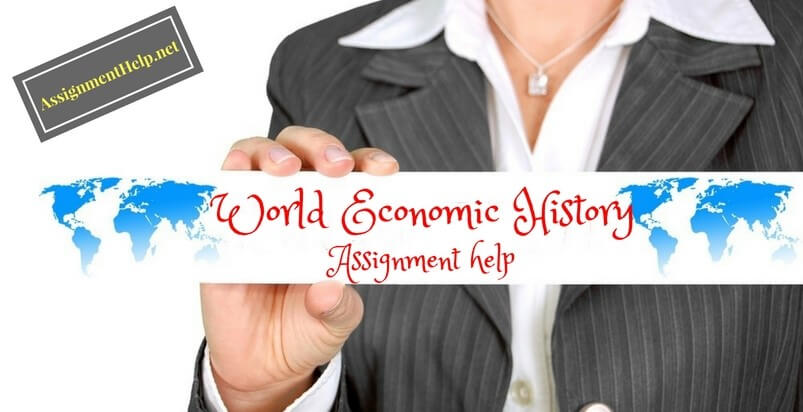World Economic History Assignment Help
About World Economic History
As they say “ The past is behind, learn from it” which is very true because it is the lessons from the past that save us from committing the same blunders. The subject world economic history provides an overview of world economic history since the Neolithic revolution. It analyzes the main theories which have been proposed to explain these facts.
What do you mean by Economic History of the World?
The economic history of the world is a record of the economic activities which are production, distribution and consumption of goods and services of all humans. It spans both recorded history and evidenced prehistory.

Paleolithic
This age was from 500,000–10,000 BC.
The Paleolithic Era majorly focused on a primary socio-economic unit, that was a band which was small kin group. Communication between bands occurred for the purposes of trading ideas and tools, stories, skins, foods, and other commodities, and for the exchange of mates. Economic resources were constrained by typical ecosystem factors: replacement rates and density of edible flora and fauna, competition from other consumers which is the organisms and climate. Throughout the upper Paleolithic, humans both dispersed and adapted to a greater variety of environments, and also developed their technologies and behaviors to increase productivity in existing environments taking the global population to around 15 million. It has been estimated that throughout prehistory, the world average GDP per capita was about $158 per annum, and did not rise much until the Industrial Revolution.

Mesolithic
This period started after the end of the last glacial period, which was over 10,000 years ago involving the gradual and nominal domestication of animals and plants and also the stabilized formation of the numerous communities at various places and a period of time.
Neolithic
Each tribe had special qualities and each member of these tribes were differentiated to certain activities, and the nature of some of these activities were limited by the resources which were naturally present and available from within each tribe's territory. This created specialization of skills. With the advent of division of labor and evolution of new crafts, tribal units became naturally isolated through time from the over-all developments in skill and technique present within their neighboring environment. To utilize artifacts made by tribes specializing in areas of production not present to other tribes, exchange and trade became necessary. The first mode or physical thing used specially in a way similar enough to the modern definition of money was the barter of cattle. Long before market economies existed, people relied on tradition, top-down command, or community cooperation.
Early developments in formal money and finance
The city conditions of Sumer built up an exchange and market economy construct initially in light of the product cash of the shekel which was a sure weight measure of grain, while Babylonian settlements were the main who built up the most punctual arrangement of costs utilizing standard metric of different supplies and wares that was utilized for settling in a lawful code. Their neighboring city and state later tailed them in this. History’s first creditors were the temples, who started in the beginning of the summer in the third millennium. They used to charge interest and also ground rent on the assets and the properties which were owned by themselves. The temples helped in legitimizing the idea of interest‑bearing debt and profit seeking in general. Later on the temples no longer included the handicraft workshops which characterized third‑millennium Mesopotamia, in their embassy functions they legitimized profit‑seeking trade, as well as by being a major beneficiary.
World Economic History Assignment Help By Online Tutoring and Guided Sessions from AssignmentHelp.Net
Classical Era
India and China are the two largest economies in the world, and are accounted for more than half the stature of the world economy. Despite the high GDP, these nations being major population centers, did not have significantly higher GDP per capita.
Expedition and long distance commerce
The two enormous changes in commercial activity due to expedition known by historical recounting, are those led by Alexander the Great, which facilitated multi-national trade, and the conquest to empire of Caesar, who was a Roman, of France and Britain.
External trade with the Roman Empire
During the time of the trade of the Occident with Rome, Egypt was the wealthiest of all places within the Roman Empire. The merchants of Rome acquired produce from Persia through Egypt, by way of the port of Berenice, and subsequently the Nile.
The introduction of coinage
As per Herodotus’ claim, the Lydians were the first people, who introduced the prime use of gold and silver coin. It was considered that these first stamped coins were minted around 650–600 BC. A stater coin was made in the stater or trite denomination. To complement the stater, fractions were made: the trite or third, the hekte or sixth, and so on in lower denominations. Developments in economic awareness and thought. The first economist in this world is considered to be Hesiod, due to the fact of his having written on the fundamental subject of the scarcity of resources, in Works and Days. Indian thinker and economist Chanakya wrote Arthshastra, which is a book on science of economics in contemporary India in 4th century BC.
Middle Ages
During the Middle Ages the world economy slowly graduated with the increase of population and trade. The silk road was used for trading between Europe, China and Central Asia. During the early period of the Middle Ages, Europe was an economic stalwart, however, by the later Medieval period rich trading cities in Italy emerged, as it created the first modern accounting and finance systems. The first banknotes were used in Tang dynasty China in the ninth century and later with expanded use during the Song dynasty.
Early Modern Era
The Early modern era was a time of mercantilism, nationalism, and international trade. The waning of Feudalism saw new national economic frameworks begin to be strengthened. After the voyages of Christopher Columbus. It amazingly opened up new opportunities for trade with the New World and Asia, newly-powerful monarchies wanted a more powerful military state to boost their status. Mercantilism was a political movement and an economic theory that advocated the use of the state's military power to ensure that local markets and supply sources were protected. Stockholms Banco issued the very first banknote in Europe in 1661.
The Industrial Revolution
A Watt steam engine, which is a steam engine fueled primarily by coal that resulted in the Industrial Revolution in Britain and the rest of the world. The economic history of the world is majorly related to the prominent economic growth which was shown in the Industrial revolution period. It came into modern sense due to Industrial Revolution. It was because of the high amounts of energy conversion which took place at that time.
The twentieth century
Economic growth in particular took over all of the world during the twentieth century start, and this was primarily due to the quintupled world GDP per capita at that time. The highest growth occurred in the 1960s during post-war reconstruction. Some increase in the volume of international trade is due to the reclassification of within-country trade to international trade – because of increasing number of countries and resulting changes in national boundaries. The effect is small. In particular, shipping containers revolutionized trade in the second half of the century, by making it cheaper to transport goods, especially internationally.
World Economic History Assignment Help | World Economic History Homework Help | Macroeconomics Help | Macroeconomics Assignment Help | Macroeconomics Homework Help | Macroeconomics Help Online | Help With Macroeconomics Homework | Homework Help Macroeconomics | Help In Macroeconomics | Help With Macroeconomics | Free Macroeconomics Help | Macroeconomics Study Help | Macroeconomics Assignment | Assignment Of Macroeconomics | Online tutoring
